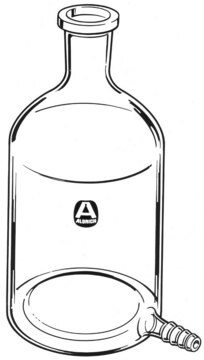Wichtige Dokumente
700355
Titan(IV)-oxid, Mischung aus Rutil und Anatas
nanoparticle, <250 nm particle size (DLS), paste, 53-57 wt. % in diethylene glycol monobutyl ether/ethylene glycol, 99.9% trace metals basis
Synonym(e):
Titandioxid
About This Item
Empfohlene Produkte
Assay
99.9% trace metals basis
Form
nanoparticle
paste
Konzentration
53-57 wt. % in diethylene glycol monobutyl ether/ethylene glycol
Oberflächenbereich
50 m2/g × 18 , BET surface area of starting nanopowder
Partikelgröße
~21 nm (primary particle size of starting nanopowder)
<250 nm (DLS)
Viskosität
<1.5 mPa.s
bp
>200 °C
Dichte
1.8 g/mL±0.2 at 25 °C
SMILES String
O=[Ti]=O
InChI
1S/2O.Ti
InChIKey
GWEVSGVZZGPLCZ-UHFFFAOYSA-N
Suchen Sie nach ähnlichen Produkten? Aufrufen Leitfaden zum Produktvergleich
Allgemeine Beschreibung
Rechtliche Hinweise
Signalwort
Danger
H-Sätze
Gefahreneinstufungen
Eye Dam. 1 - STOT RE 2 Oral
Zielorgane
Kidney
Lagerklassenschlüssel
10 - Combustible liquids
WGK
WGK 1
Flammpunkt (°F)
Not applicable
Flammpunkt (°C)
Not applicable
Persönliche Schutzausrüstung
Faceshields, Gloves, Goggles, type ABEK (EN14387) respirator filter
Hier finden Sie alle aktuellen Versionen:
Analysenzertifikate (COA)
Die passende Version wird nicht angezeigt?
Wenn Sie eine bestimmte Version benötigen, können Sie anhand der Lot- oder Chargennummer nach einem spezifischen Zertifikat suchen.
Besitzen Sie dieses Produkt bereits?
In der Dokumentenbibliothek finden Sie die Dokumentation zu den Produkten, die Sie kürzlich erworben haben.
Kunden haben sich ebenfalls angesehen
Artikel
Dye-sensitized solar cells directly convert sunlight to electricity
Over the last decade, dye-sensitized solar cells (DSSCs) have attracted much attention because these unconventional solar cells exhibit high performance and have the potential for low-cost production.
One of the more traditional photovoltaic devices, single crystalline silicon solar cells were invented more than 50 years ago, currently make up 94% of the market. Single crystalline silicon solar cells operate on the principle of p-n junctions formed by joining p-type and n-type semiconductors.
Titanium dioxide (TiO2) is an important n-type semiconducting material that shows interesting characteristics such as photoswitchable surface wettability, high photocatalytic activity, bistable electrical resistance states and high electron drift mobility.
Unser Team von Wissenschaftlern verfügt über Erfahrung in allen Forschungsbereichen einschließlich Life Science, Materialwissenschaften, chemischer Synthese, Chromatographie, Analytik und vielen mehr..
Setzen Sie sich mit dem technischen Dienst in Verbindung.



